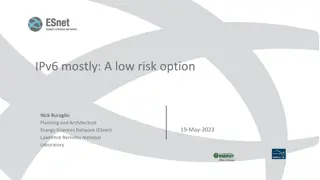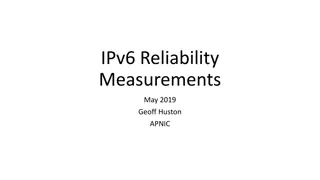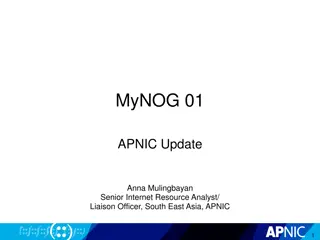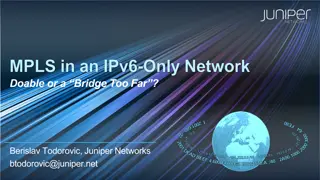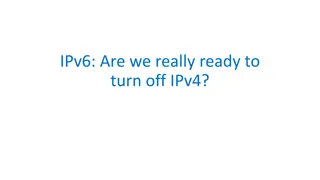IPv6 Networking Considerations in xDSL Networks
Practical insights and challenges in implementing IPv6 networking in xDSL networks, discussing rotating prefixes, privacy implications, management of multiple prefixes, prefix size considerations, and strategies for DHCP and L2TP termination. The content also covers security measures, prefix rotation experiments, and strategies for prefix assignment and route management.
Download Presentation

Please find below an Image/Link to download the presentation.
The content on the website is provided AS IS for your information and personal use only. It may not be sold, licensed, or shared on other websites without obtaining consent from the author.If you encounter any issues during the download, it is possible that the publisher has removed the file from their server.
You are allowed to download the files provided on this website for personal or commercial use, subject to the condition that they are used lawfully. All files are the property of their respective owners.
The content on the website is provided AS IS for your information and personal use only. It may not be sold, licensed, or shared on other websites without obtaining consent from the author.
E N D
Presentation Transcript
Rotating Prefixes in xDSL networks Lutz Donnerhacke IKS Service GmbH
IPv6 the privacy killer Standards leaks EUI-64 maps MAC into public IPs Allows tracking of devices across networks Privacy extensions are optional Provider accidentally leaks Routing aggregation groups dynamic prefixes Prefix not changed without reconnection (long time) Allows tracking by prefix even with privacy extensions Prefix change prevents server operation
Multiple prefixes Hand out three prefixes A dynamic prefix D1 for new connections A dynamic prefix D2 for still open connections A stable prefix S for server operation Preferred vs. valid lifetime New connections use preferred lifetime > 0 Only D1 has positive preferred lifetime Connection can stay open until valid lifetime is reached D2 is the most recent D1 to keep open connections S has a really long valid lifetime
Rotating prefixes yesterday 2001:db8:0:1234::/64 (1d/2d) 2001:db8:0:5678::/64 (0d/1d) 2001:db8:1:c001::/64 (0d/7d) today 2001:db8:0:5217::/64 (1d/2d) 2001:db8:0:1234::/64 (0d/1d) 2001:db8:1:c001::/64 (0d/7d) tomorrow 2001:db8:0:4e20::/64 (1d/2d) 2001:db8:0:5217::/64 (0d/1d) 2001:db8:1:c001::/64 (0d/7d)
Practical considerations Prefix size AVM needs at least /60 for LAN, Guest, and Uplink AVM behind AVM (extender) requires /59 for PD Rotation time Experiments: hourly rotation, 1h preferred, 2h valid CPE can request used prefixes to be extended Different pools per hour (4 bit) Pool size For randomness three times the customer count 50k customers * /60 -> /44 * 16h -> /40 * 3 -> /38 minimum Add large enough pool for static assignment, aggregateable
Where to act PPP L2TP termination via improved mpd (other talk) Divert DHCP using ipfw on ng* Perl-Script to assign prefixes and adding routes to kernel Works since years DHCP Routes need to be added on Router -> DHCP relay Central DHCP server managing prefixes Did not work for years
IPv6 in L2 switched xDSL-networks Carriers filter aggressively No broadcast to the CPE (beside ARP to the learned IP) No multicast to the CPE No unknown multicast in the network No multicast -> no ICMPv6 -> no IPv6 AVM tries SLAAC (fails), then blindly send DHCPv6 We see DHCPv6 requests from CPE Router does not forward DHCPv6 responses to CPE Router miss ICMPv6 ND responses (multicasted)
Fixing IPv6 in L2 switched xDSL-networks Obtain DLSAM Project for tests with carrier Technician only meetings Get console access and documentation Try almost all IPv6 related option: icmpv6-sec-fltr Adding security opens the multicast channels Outside the lab Option will not be rolled out Fake the ND responses, like we fake ARP since years
Faking ND in production Extending parpd Derive MAC from EUI-64 link-local IP Learn and respond to normal ND traffic Monitor unmatched ND traffic interface lagg140 timeout 1.164 rule 0.0.0.0/0 0.0.0.0/0 ignore rule6 fe80::/96 fe80::/64 eui rule6 fe80::/64 fe80::/64 tell rule6 ::/0 ::/0 verbose ignore end
Prefixes in production show ipv6 dhcp relay binding Total number of Relay bindings = 261 Total number of IAPD bindings = 261 Total number of IANA bindings = 0 Total number of Relay bindings added by Bulk lease = 0 show ipv6 route static S 2A01:75C0:1140:E200::/60 [1/0] via FE80::464E:6DFF:FE20:7F73, Vlan140 S 2A01:75C0:1140:E280::/60 [1/0] via FE80::464E:6DFF:FE5D:B7D9, Vlan140 S 2A01:75C0:1140:E4E0::/60 [1/0] via FE80::E228:6DFF:FE28:3C32, Vlan140 S 2A01:75C0:1140:E5A0::/60 [1/0]
IPv6 is really used 00:07:16.429150 fe80::51:140 > fe80::ca0e:14ff:fe29:e316: [icmp6 sum ok] icmp6: neighbor sol: who has fe80::ca0e:14ff:fe29:e316(src lladdr: 5c:83:8f:3b:6f:3f) [class 0xe0] (len 32, hlim 255) Unicasted ND query from the router for a CPE. (not seen by parpd) 00:07:16.446221 fe80::ca0e:14ff:fe29:e316 > fe80::51:140: [icmp6 sum ok] icmp6: neighbor adv: tgt is fe80::ca0e:14ff:fe29:e316(SO)(tgt lladdr: c8:0e:14:29:e3:16) (len 32, hlim 255) Real ND response from the CPE. 00:07:16.537675 2a01:75c0:1140:ff90:219:99ff:fe99:2b8e.33270 > 2a01:4f8:202:34a2:2:100:0:111.443: P [tcp sum ok] 2818149766:2818150359(593) ack 2150523048 win 1432 <nop,nop,timestamp 352457737 615010237> [flowlabel 0xb79fc] (len 625, hlim 63) 00:07:16.567626 2a01:4f8:202:34a2:2:100:0:111.443 > 2a01:75c0:1140:ff90:219:99ff:fe99:2b8e.33270: P [tcp sum ok] 1:209(208) ack 593 win 899 <nop,nop,timestamp 615010987 352457737> [flowlabel 0x92afe] (len 240, hlim 55) 00:07:16.581155 2a01:75c0:1140:ff90:219:99ff:fe99:2b8e.33270 > 2a01:4f8:202:34a2:2:100:0:111.443: . [tcp sum ok] 593:593(0) ack 209 win 1432 <nop,nop,timestamp 352457780 615010987> [flowlabel 0xb79fc] (len 32, hlim 63)










